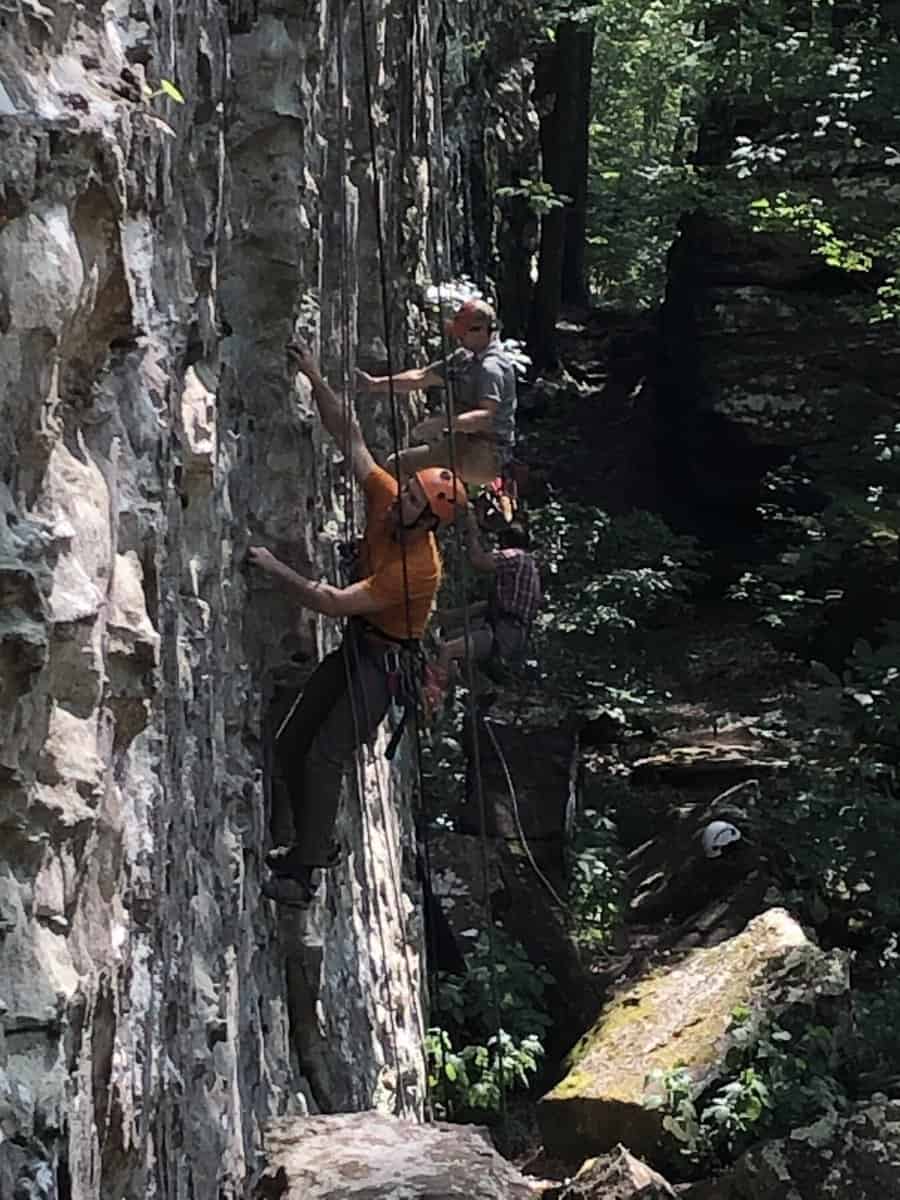Under construction for hundreds of millions of years, the Pennsylvania sandstone cliffs that dot southern Illinois have long been cherished by climbers. But since the 1960s, rock warriors have had access to only a handful of cliffs in Ferne Clyffe State Park near Goreville, Illinois.
Until now.
This fall, the Illinois Department of Natural Resources (IDNR) and the Illinois Climbing Association (ICA) officially opened about 50 new sport climbing routes in the park — with plans to open another 50 in coming years
“Ferne Clyffe is one of the best sport-climbing resources in Illinois, second only to Jackson Falls,” said Dave Hug, assistant superintendent of Ferne Clyffe and an ICA board member. “In fact, it’s made up of the same rock as Jackson Falls, in a canyon that was carved at about the same time.”
That rock, which Hug described as “bullet-hard sandstone,” is perfect for holding the modern, stainless-steel safety anchors used for sport climbing. Hug believes the anchors are one of the most important parts of the project
“The only reason climbing hasn’t been popular at Ferne Clyffe is the lack of safety anchors,” he said. “Sport climbing is like the indoor climbing people love, but outdoors. We are confident that this park will now become one of the most popular climbing destinations in Illinois.”
Impact and Awareness
In addition to safety, the new sport-climbing sites at Ferne Clyffe offer a less environmentally impactful alternative to top-rope climbing, which dominated Ferne Clyffe for the last 60 years.
“With top-rope climbing, climbers start by installing an anchor at the top of the cliff to hold their ropes. That increased activity did some damage to the sensitive plant communities that live at the cliff tops,” said Jay Massey, Ferne Clyffe site superintendent for IDNR.

New climbing anchors at Ferne Clyffe State Park.
“With sport climbing, traffic at the top is virtually nonexistent,” Massey continued. “All the foot traffic is limited to already established trails at the base of the cliffs.”
Massey expects to see foot traffic grow with the new climbing opportunities, fulfilling another IDNR mission: increasing awareness of the outdoors.
“Bringing people into our state parks where they can participate in outdoor activities is essential,” he said.
Ferne Clyffe has a long history of drawing people to nature. The park started as a private attraction in the early 1920s. But in 1949, its owner, former schoolteacher and administrator Emma Rebman, sold it to the state of Illinois. Once the state opened the park to the public, people began flocking to its waterfalls, scenic overlooks, nature preserves — and cliffs.
Hug said the first officially recorded rock climb at Ferne Clyffe took place in 1962, when the Shawnee Mountaineers, a climbing club out of Southern Illinois University-Carbondale, scaled the cliffs. Countless others followed after them.
Then, in 1991, the IDNR and the U.S. Forest Service began discussing a land swap that would greatly expand the park and place it under a professional management plan. Four years later, they reached an agreement. The park grew from 140 acres to 2,340 acres, but the deal restricted climbing to sites accessible from only two trails, Rebman and Cedar Bluff.
Team Effort
The effort to bring sport climbing to new and reopened sites at Ferne Clyffe goes back nearly a decade, when the ICA and IDNR collaborated on climbing projects at Pere Marquette and Giant City state parks.
“The ICA and IDNR have worked together for a long time, but the Pere Marquette and Giant City projects became the catalyst for our work at Ferne Clyffe,” said Kevin Sierzega, another ICA board member. “The Pere Marquette project’s success, especially, allowed ICA to build their reputation and trust with the IDNR. That was critical to completing the Ferne Clyffe project.”
However, the ICA and IDNR refuse to take all the credit for the project. Hug said the work required about 800 volunteer hours, with most of it done outdoors during the planet’s hottest summer on record.
ICA board member Mimi Harzan was among the volunteers.

Volunteers spent about 800 hours setting new climbing routes at Ferne Clyffe.
“Seeing those routes come to life as we planned our bolt placements was very exciting, because Ferne Clyffe has a plethora of overhanging routes for the intermediate climber,” Harzan said. “I’m very grateful to the park for recognizing the potential for additional recreational activities, and I know it will be an economic boost to the area, because I’ve already spent a paycheck or so in gas and Gatorade!”
The hard work was worth it for Hug and Massey, too.
“As stewards of the park, our goal is to open as many opportunities for recreation as we can at Ferne Clyffe,” Hug said. “Rock climbing was a no-brainer. We already allowed for it, if on a much smaller scale, so why not update it and make it safer and more accessible to everyone?”
Added Massey, “As people understand and appreciate our natural resources, they will be more likely to become partners in helping IDNR manage, preserve, and protect them.”
Getting There
Ferne Clyffe State Park is located at 90 Goreville Road in Johnson County, Illinois, about a two-hour drive (132 miles) from downtown St. Louis. The nearest town is Goreville, Illinois, and the nearest connection to a highway is Exit 7 on the Illinois portion of Interstate 24. To get more information, call 618-995-2411 or visit dnr.illinois.gov/parks/park.ferneclyffe.html.
Author: Tim Fox is a regular contributor to Terrain Magazine.


Leave A Comment